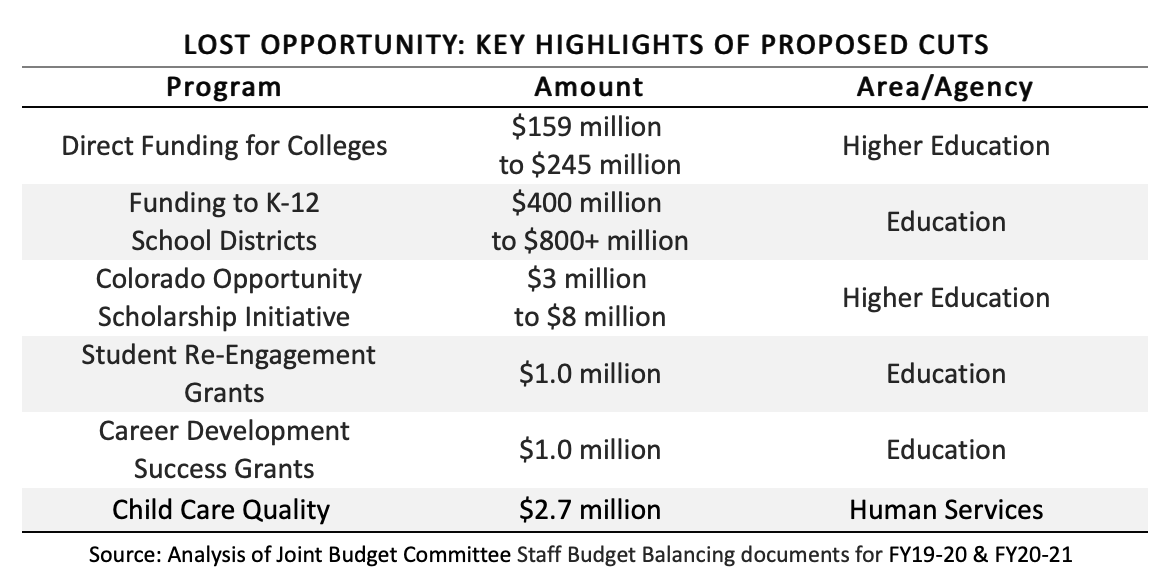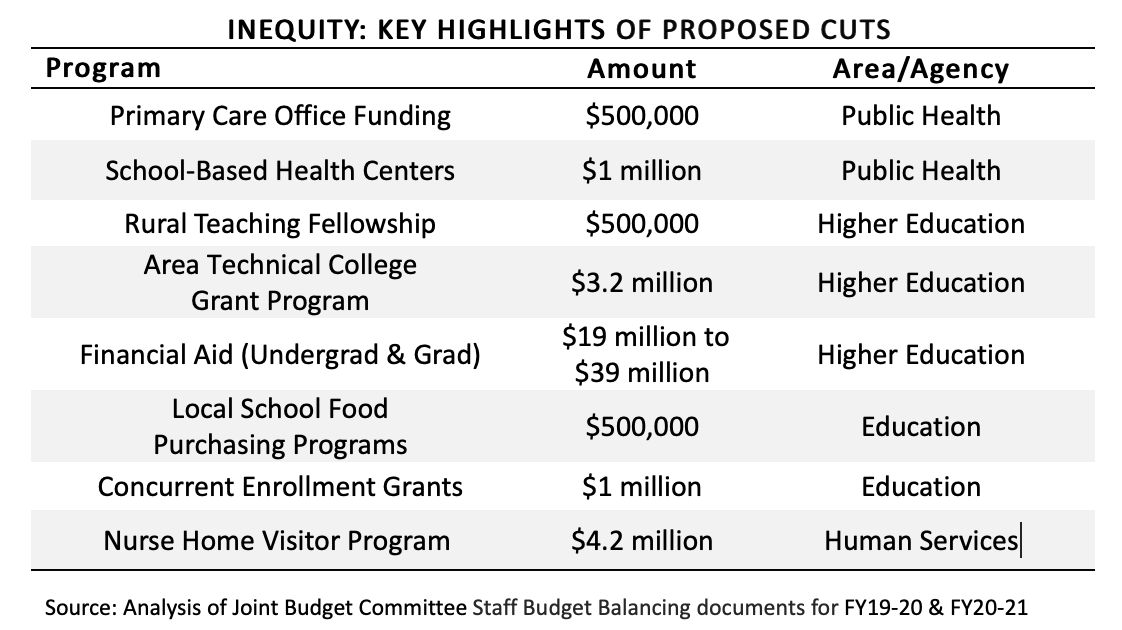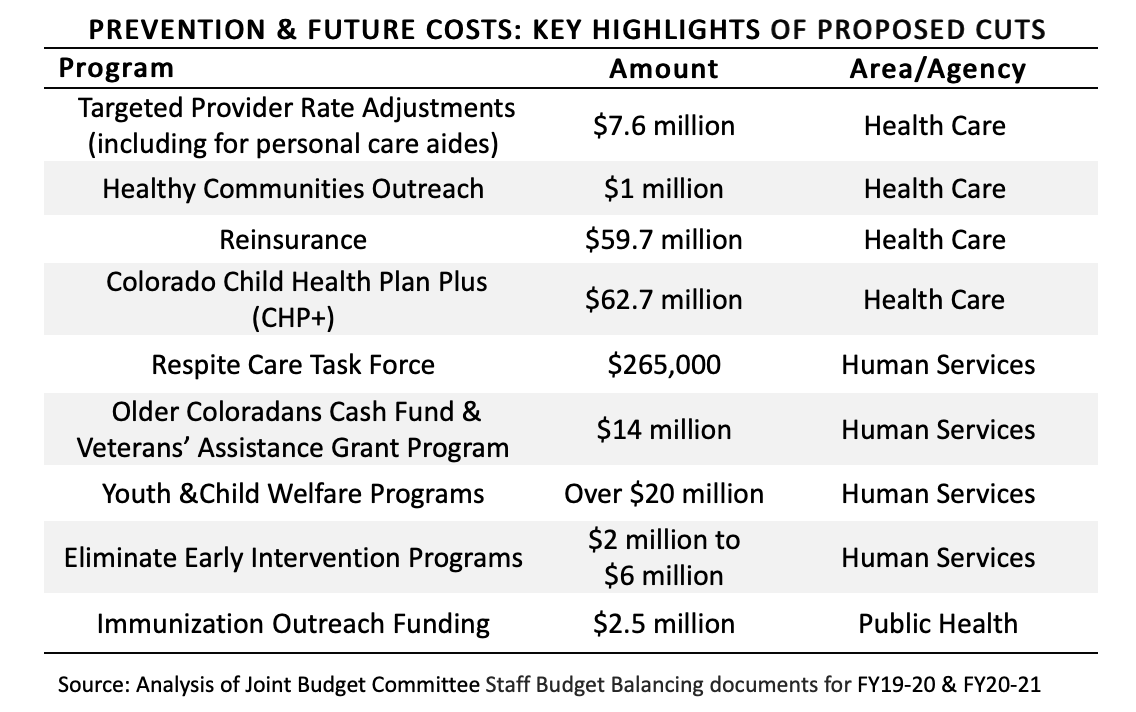Revenue Shortfalls: Lost Opportunity, Increased Inequity, & Future Costs
Colorado is approaching a fiscal nightmare, with the economic consequences of the global pandemic compounding existing challenges in a state with outdated limits on raising taxes. When the Joint Budget Committee (JBC) returns on May 12, it could be facing a forecast of more than $3 billion in lost revenue. As Republicans in Congress refuse to expand federal aid to backfill lost state revenue, Colorado will have to cut programs that have major benefits to communities across the state.
JBC staff recently released proposals for large cut, but those are not likely enough to account for the lost revenue. We know from the Great Recession that these types of cuts lead to vast disparities in Colorado. There are no easy choices, especially when considering where most state General Fund dollars go: The four largest areas are education, health, human services, and higher education.
The proposed cuts that may be necessary will have a dramatic negative effect on future opportunities for Coloradans, existing inequities, and future costs. If we fail to act now, action becomes more expensive later and outcomes will be more inequitable. We still can stop this through federal action and efforts to raise revenue. Below we outline some of the proposed cuts.
Lost Opportunity
Spending cuts are likely to target the Departments of Education (CDE) and Higher Education (CDHE), due in part to both fewer constitutional obligations to fund higher education and the significant share of state spending these areas comprise. In making these cuts, Colorado runs the risk of failing a generation of Colorado children by not providing them the resources they need to learn and gain the skills for work that leads to greater opportunity.
With key, evidence-based, programs like full-day kindergarten potentially on the chopping block, we know our decisions today may lead to a generation whose outcomes are worse off than their parents. Most at risk are our institutions themselves, where core funding faces cuts and enrollment decreases mean potential closures of colleges in areas across Colorado, including many rural areas.

Creating Further Inequity
Public investment is fundamental to addressing long, persistent inequities within our state. These have manifested themselves in a large racial wealth gap, a rural-urban divide, significant racial disparities in health outcomes, and unequal access to opportunities for economic advancement.
The JBC and the legislature has yet to dive into some of the large cuts that may have even worse equity implications — such as dramatic reduction in per-pupil funding for districts — but the proposed cuts outlined have large consequences already. School-based health centers locate health clinics on school property provide primary, behavioral and oral health services, particularly for low-income children and youth, and assist with enrollment in children’s health plans. Concurrent enrollment helps students attain college credit while in high school, thus reducing the overall costs of college and making college more accessible to many students. Nurse home visitor programs provide critical services to low-income mothers at a time when those services can set children on a strong trajectory.
Many other proposed cuts have deep equity considerations, but below are just some highlights.
Prevention & Future Costs
Strong public policy recognizes the need for investment: investment in families, investment in systems, investment in communities. These investments demonstrate a recognition that proactively putting money into proven solutions can mitigate more acute — and expensive — problems in the future.
Over the years, we’ve seen our legislature invest in powerful and proven solutions. That’s why our state provides preventative health care to children, has taken steps to raise wages for direct care workers, and invested in systems that deliver essential home- and community-based services for older adults. Though they require an investment of state funding, these efforts pay dividends far into the future. They can prevent acute health problems, create a stronger workforce, and allow for the development of a robust system that promotes long-term economic mobility and opportunity.
Several of the most notable possible cuts in preventative services include:
Alternatives to Setting Colorado Back
Like Colorado, most states cannot deficit spend like the federal government. That’s why federal aid during a global pandemic of unprecedented proportions is critical to our future. Congress still has an opportunity to act and prevent setbacks to states that could last for decades.
There are alternatives to a cuts-only approach to this shortfall. Many questions have arisen around TABOR’s emergency’s tax provisions that needs answers. Voters may also be asked in November if the state can update its tax code to increase revenues through a proposal to raise tax rates on wealthier households. Whatever the proposed remedy, revenue must be on the table to fill a hole as big as this.


